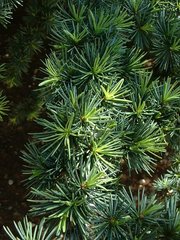Cedar
|
|
| Cedars | ||||||||||||
|---|---|---|---|---|---|---|---|---|---|---|---|---|
| Missing image Cedre-large.jpg A cedar in a French garden | ||||||||||||
| Scientific classification | ||||||||||||
| ||||||||||||
| Species | ||||||||||||
|
Cedrus deodara |
Cedar correctly refers to those trees belonging to the genus Cedrus in the coniferous plant family Pinaceae. They are most closely related to the Firs (Abies), sharing a very similar cone structure. They are native to the mountains of the western Himalaya and the Mediterranean region, occurring at altitudes of 1,500-3200 m in the Himalaya and 1,000-2,200 m in the Mediterranean.
They are trees up to 40-50 m (occasionally 60 m) tall with spicy-resinous scented wood, thick ridged or square-cracked bark, and broad, level branches. The shoots are dimorphic, with long shoots, which form the framework of the branches, and short shoots, which carry most of the leaves. The leaves are evergreen and needle-like, 8-60 mm long, arranged singly in an open spiral phyllotaxis on long shoots, and in dense spiral clusters on short shoots; they vary from bright grass-green to dark green to strongly glaucous pale blue-green, depending on the thickness of the white wax layer which protects the leaves from desiccation. The cones are barrel-shaped, 6-12 cm long, and, as in Abies, disintegrate at maturity to release the winged seeds. The seeds are 10-15 mm long, with a 20-30 mm wing; as in Abies, the seeds have 2-3 resin blisters, containing an unpleasant-tasting resin, thought to be a defence against squirrel predation. Cone maturation takes one year, with pollination in September-October and the seeds maturing the same time a year later.
There are five taxa of Cedrus, assigned according to taxonomic opinion to two to four different species:
- Deodar Cedar Cedrus deodara. Western Himalaya. Leaves bright green to pale glaucous green, 25-60 mm; cones with slightly ridged scales.
- Lebanon Cedar or Cedar of Lebanon Cedrus libani. Mountains of the Mediterranean region, from Turkey and Lebanon west to Morocco. Leaves dark green to glaucous blue-green, 8-25 mm; cones with smooth scales; four varieties, which are treated as species by many authors:
- Lebanon Cedar Cedrus libani var. libani Mountains of Lebanon, western Syria and south-central Turkey. Leaves dark green to glaucous blue-green, 10-25 mm.
- Turkish Cedar Cedrus libani var. stenocoma Mountains of southwest Turkey. Leaves glaucous blue-green, 8-25 mm.
- Cyprus Cedar Cedrus libani var. brevifolia or Cedrus brevifolia. Mountains of Cyprus. Leaves glaucous blue-green, 8-20 mm.
- Atlas Cedar Cedrus libani var. atlantica or Cedrus atlantica. Atlas mountains in Morocco & Algeria. Leaves dark green to glaucous blue-green, 10-25 mm.
Cedar_needle_branchlet,_one.jpg
Uses
Cedrus_wood.jpg
Cedars are very popular ornamental trees, widely used in horticulture in temperate climates where winter temperatures do not fall below about -25°C (the Turkish Cedar is slightly hardier, to -30°C or just below). They are also grown for their durable (decay-resistant) scented wood, most famously used in the construction of King Solomon's temple in Jerusalem. Extensive reforestation of cedar is carried out in the Mediterranean region, particularly Turkey, where over 50 million young cedars are being planted annually.
External links
- Arboretum de Villardebelle - cone photos (http://www.pinetum.org/cones/PIcones.htm) (scroll to bottom of page)
- Arboretum de Villardebelle - Turkey (http://www.pinetum.org/PhotoMPF2.htm) some photos of Cedrus libani var. stenocoma in the wild
- Gymnosperm Database - Cedrus (http://www.botanik.uni-bonn.de/conifers/pi/ce/index.htm)
Links to other Pinaceae
Pinus - Picea - Cathaya - Larix - Pseudotsuga - Abies - Cedrus - Keteleeria - Pseudolarix - Nothotsuga - Tsuga
The name cedar has also been mis-applied to many other trees with scented wood, including in the genera Calocedrus ("incense-cedars"), Chamaecyparis ("whitecedar"), Cryptomeria (once called "Japanese cedar"), Juniperus ("Eastern redcedar" and "Mountain-cedar") and Thuja ("Western redcedar") in the family Cupressaceae; Cedrela ("Spanish-cedar") and Toona ("Australian Redcedar", among others) in the family Meliaceae; and Tamarix ("Saltcedar") in the family Tamaricaceae.da:Ceder (Cedrus) de:Zedern es:Cedrus eo:Cedro fr:Cèdre it:Cedrus he:ארז nl:Ceder pl:Cedr ru:Кедр tr:Sedir

